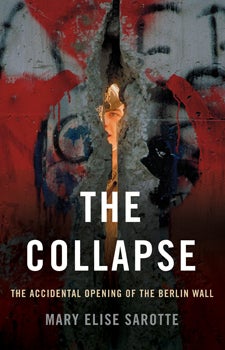From Berlin to Baghdad?
On the evening of Nov. 9, 1989, Americans were tuned to their televisions watching “NBC Nightly News” anchorman Tom Brokaw report from West Germany. It was a momentous occasion. The Berlin Wall, a 28-year symbol of divided Cold War Europe, was coming down.
Twenty-five years later, the circumstances that led to the collapse of the Berlin Wall are still widely unknown to Americans, said Mary Elise Sarotte, Dean’s Professor of History and professor of international relations at USC Dornsife. While many believe it was the result of an agreement between former President Ronald Reagan and former Soviet leader Mikhail Gorbachev, Sarotte’s new book The Collapse: The Accidental Opening of the Berlin Wall (Basic Books), due out this October, shows how the wall’s demise was actually a series of accidents.
“This story is pretty well known in Germany though it’s not well known in the United States,” Sarotte said. “The book intends to introduce the story to an English-speaking audience.”
Sarotte identifies both long-term and short-term causes that led to the wall’s collapse. In the long term, she noted that the superpower contest between the U.S. and the Soviet Union was becoming unsustainable for the Soviet Union. “The Soviet Union was unable to provide for its own people and it was unable to keep up with the arms race,” she said.
Then, in the late ’80s, two parallel processes took place in East Germany that finally set events into motion.
“The East German hardline regime was breaking down and making mistakes,” Sarotte said. “Meanwhile, a peaceful revolution was percolating. It was disorganized at first but then it began to get its act together and take advantage of the cracks in the regime.”
Sarotte traces how the regime tried to quiet down protests by making false promises. In a carelessly worded press announcement, the East German Politburo declared that East Germans would get new travel freedoms. At the time, East Germans faced extensive restrictions on any travel.
“The regime botches the announcement so badly that is sounds like they’re announcing real travel freedoms,” Sarotte explained. “At this point, the revolutionaries are so well organized that they can seize on that, and tens of thousands of people start showing up at the wall saying, ‘The wall’s open!’ ”

The Collapse: The Accidental Opening of the Berlin Wall (Basic Books) chronicles eyewitness accounts during the destruction of the Berlin Wall. The book is slated for publication Oct. 7, 2014.
“Border guards have no orders, and they don’t know what’s going on because the new travel regulations weren’t real,” Sarotte said. “Nobody told them not to open up the wall but here are ten thousand people standing in front of them saying the wall should be open. So there’s this interesting contest of wills at the wall where the crowds convince the border guards that the wall is open even though it’s not.”
The Collapse follows roughly a dozen witnesses on the night the wall opens.
“It’s about ordinary people placed under intense pressure making the best decisions they can, and the unintended consequences that result,” Sarotte said.
Sarotte is a historian of international relations. Her research focuses on U.S. and European foreign policy in the 20th century, particularly during the Cold War. A former White House fellow and Humboldt Research fellow, she is a member of the Council on Foreign Relations, a nonpartisan think tank. Her book, 1989: The Struggle to Create Post-Cold War Europe (Princeton University Press, 2011), examined the global politics that followed the collapse of the Berlin Wall.
To trace the events that led to the wall’s destruction, Sarotte conducted more than 50 interviews across Europe, speaking with former revolutionaries, border guards, Communist party officials, smugglers and journalists, including Tom Brokaw. Brokaw was one of the only American TV journalists reporting from the Berlin Wall with a full news crew when the wall came down.
This November, exactly 25 years after the collapse of the Berlin Wall, Sarotte will re-interview Brokaw about what took place that evening in 1989 at a public event to be held at the 92nd Street Y cultural and community center in New York City.
“This is not a story about high-level politicians,” Sarotte said. “It’s a story about people you’ve never heard of. The goal of the book is to let them speak in their own voices and get credit for their accomplishments, and in some cases, for their mistakes.”
Sarotte carefully checked her sources against files kept by the Stasi — the East German secret police. In Berlin, she studied archival files housed by the Agency of the Federal Commissioner for Stasi Records, which is tasked with preserving and protecting secret police and foreign intelligence documents from the Cold War period.
Her goal in examining the collapse of the Berlin Wall is to show how the U.S. triumphalist misunderstanding of the event has had an impact on U.S. foreign policy to this day.
“There’s actually a saying ‘From Berlin to Baghdad,’ ” Sarotte explained. “The idea is that because the U.S. successfully brought down the wall without help from anyone else, we can do the same things everywhere else and we can do it just as quickly and just as peacefully with no cost. That’s a misreading of what happened, and it ignores the agency of the local actors who were very important.”
It’s also a story of universal significance about how a peaceful revolution succeeds, Sarotte said.
“This was a genuinely peaceful revolution that overcame a wall and what it symbolized,” she said. “What had to go right for that to happen? As human beings, it’s worth understanding.”